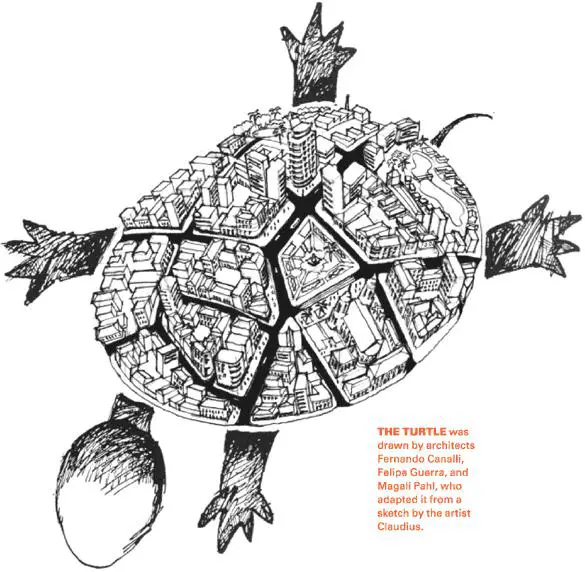By Jaime Lerner
The city of today is too often a campground, an unchecked metastasis. It is either an ever-spreading Atlanta or Los Angeles – an endless suburb unable to contain and sustain itself – or a frightening Gotham of skyscrapers huddled over dark concrete valleys. It is a place without priority, logic, or true consideration of its residents needs.

By contrast, consider a turtle’s shell: a house upon the back of its self-sufficient occupant. Have you ever noticed that the meticulously organized outer surface resembles an aerial view of a city? The shell’s pattern evokes the cells that constitute urban tissue – blocks, streets, and functional centers. A turtle-shell city is a place to live, to work, to relax and play. In all, it is a circumscribed, homey shelter.
This schematic drawing of a turtle can help you imagine some of the important features of the ideal urban environment, built upon principles of mobility, sustainability, and cultural identity. In the denser area of the turtle-shell city, identified by the taller edifices, you can find apartments, office buildings, mixed-use structures (with residential, commercial, and service functions), as well as street-level attractions – a bakery for morning bread, a fancy bistro for business lunches, a newsstand with reading material for bus rides, a town square, a church, an art gallery. Supporting the high-density area is an ecologically sustainable mass transportation system that, whether it operates on the surface or underground, is fast, safe, comfortable, and accessible to all. It’s also part of a public transit network that extends throughout the community.
The turtle-shell city’s housing accommodates the needs and preferences of a broad spectrum of people. It has high- and low-rise buildings along with stand-alone homes. There are no ghettos, because neighborhoods comprise a mixture of income and age groups performing a variety of functions. The more you mix, the more livable the city becomes.
Near the residences are schools, hospitals, and workplaces. All areas are permeated by parks and gardens—keys to a healthier urban environment. Such green spaces are even part of the city’s drainage system, protecting the waterways and creating natural flood basins. Just as no part of the turtle’s shell can be changed or removed without harming the whole creature, none of these elements of the city can be altered without affecting its overall sustainability.
The city of the future will not be an accident of mindless growth. Instead, it will be a home as exquisitely and holistically designed as the turtle’s. It is where businesses will need to operate and what they must first help to create.
Jaime Lerner, architect and urban planner, is the founder of the Instituto Jaime Lerner in Curitiba, Brazil. He has formerly served as president of the International Union of Architects, governor of the Brazilian state of Paraná, and mayor of Curitiba.
This article was orginally written by Jaime Lerner.

We might see our houses
We might see our houses walking here and there if turtle awakes. Anyway this is stunning. Rusha, do you have anymore stuffs like this?
Anything can be possible..
Anything can be possible..
Hi, actually it is not just
Hi, actually it is not just about turtle…
God is the greatest architect and no doubt we can get great inspiration from nature…
Inspiration could be a concept or form.. anything.. just a vague thought…
“No building has sustained but various form of nature has.”, so why can’t we build taking inspiration from nature..
How various plants sustain themselves from natural havocs… and i am sure if we study them we can put them in construction of buildings too..
a nice metaphor….. but some
a nice metaphor….. but some way i feel almost all organisms can be referred to describe the shell created by humans that is the planet that got its form from the organisms on this planet